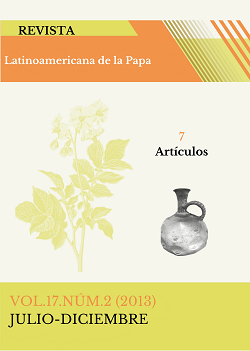Carotenoids Extracted from Promising Clones of Criolla Potato (Solanum tuberosum Group Phureja) for Food Industry
##plugins.themes.bootstrap3.article.main##
Resumen
The carotenoids are natural pigments that contribute to the replacement of the synthetic colorants which are still used in food industry. With this aim, the carotenoids from 15 promising clones and one commercial variety, named Yema de Huevo, of Criolla potato (Solanum tuberosum Group Phureja) supplied by Corpoica were extracted and evaluated. The tubers lyophilized for 72 h by triplicate, and their carotenoids extracted with acetone and hexane. Absorbance of the supernatants obtained after centrifuging measured using spectrophotometry at intervals of 3 nm. Presence of carotenoids was also confirmed by thin layer chromatography. Absorbance values showed a presence of lutein-5, 6-epoxide in clones 2, 4, 5, 6, 7, 8, 15, and α-carotene in clones 3, 10, 11, 12, 13, 14, 16, 17, and commercial variety. The promising clones 11, 12 and 14 were selected due to their higher carotenoid concentration. Their carotenoids extracted were evaluated their stability under different pH, temperature, and light conditions. A decrease in the color intensity was observed at 13.5 and 1.0 pH. There were not significant changes of color intensity at 50 and 70 °C temperatures. This carotenoids exposure to the light displayed a decrease in the absorbance. After, a commercial colorless yogurt was dyed with the selected
carotenoids. Carotenoids from promising clone 14 showed higher pigmentation according to the spatial coordinates CIELAB of L*48.66 a*-1.65 b*5.63.
Accepted for publication: August 15, 2013.
Download Statistics
##plugins.themes.bootstrap3.article.details##
raw carrot, sweet potato and supplemented chicken meat nuggets. Food Science and Technology. 44 (8): 1809-1813.
Britton, G.; S. Liaaen-Jensen; H.Pfander. 2004. Carotenoids Handbook. Basel: birkahuser.
http://books.google.com.co/books?id=lf3KX07orYIC&printsec=frontcover&dq=britton+carotenoids&hl=es&sa=X&ei=wOTZT_yMEoP28gT5qsz
rBQ&ved=0CDMQ6AEwAA#v=onepage&q=britton%20carotenoids&f=false 669 p. Consulta: Mayo, 2012
Bungard, R.; Ruvan, A.; Hibberd, J.; Press, M.; Horton, P.; Scholes, J. 1999. Unusual carotenoid composition and a new type of xanthophylls
cycle in plants. Proceedings of the National Academy of Sciences of the USA J. 96 (3): 1135–1139.
Burgos, G.; E.Salas; W. Amoros; M.Auqui; L. Muñoa; M.Kimura; M. Bonierbale. 2009. Total and individual carotenoide profiles in Solanum
phureja of cultivated potatoes: I. Concentrations and relationships as determined by spectrophotometry and HPLC. Food Composition and
Analysis J. 22 (6): 503-508.
Cerón, M.S.; C.P. Álvarez; L. Prieto; C. Arango; J. Argüelles. 2012.(CHECK ; 2012 0R 2010?) Generación de variedades mejoradas de
papa Criolla (Solanum phureja), con características morfoagronómicas, de cosecha, acondicionamiento y transformación, ideales para la exportación en el Departamento de Cundinamarca. Proyecto de investigación entre Corpoica-Universidad de La Salle financiado por el Ministerio de Agricultura y Desarrollo Rural, Colombia.
Corzo, P.; J.D. Moreno;B. Franco; L. Fierro. 2003. Manual de papa para productores. Corpoica. Ministerios de Agricultura y Desarrollo
Rural. Colombia. http://books.google.com.co/books?id=dhQxzRU9S0C&printsec=frontco
Davies, B. 1976. Carotenoids in Goodwin TW. Chemistry and biochemistry of plant pigments. Academic Press, London. 38-165 p.
Galicia, R. M. 2009. Extracción de pigmentos carotenoides en jitomate(Lycopersicon esculentum Mill.) y su aplicación en sistemas
alimentarios modelo. Tesis de doctorado, Universidad Autónoma Metropolitana, México.
ICBF. 2012. Tabla de composición de alimentos. Bienestar Familiar, Colombia. http://alimentoscolombianos.icbf.gov.co/alimentos_colombianos/consul
ta_alimento.asp Consulta: Febrero, 2012
Meléndez-Martínez, A. J.; I.M.Vicario; F.J. Heredia. 2004. Estabilidad de los carotenoides en los alimentos. Scielo. ALAN. 54 (2): 209-215
http://www.scielo.org.ve/scielo.php?pid=S0004-06222004000200011&script=sci_arttext Consulta: Marzo, 2012
Martínez, A. 2003. Carotenoides. Universidad de Antioquia, Facultad de Química Farmacéutica, Medellín. http://farmacia.udea.edu.co/~ff/carotenoides2001.pdf 10 p. Consulta: Febrero, 2012

